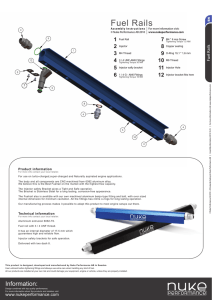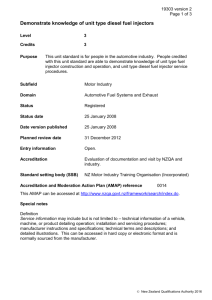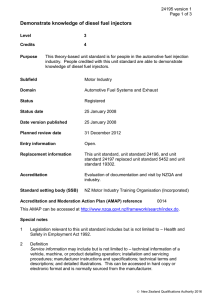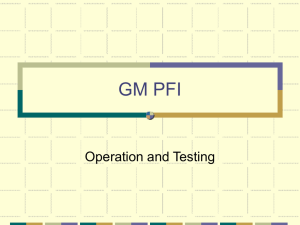6.0L ENGINE—MISFIRE, LACK OF POWER, BUCK / TSB 08-20
advertisement
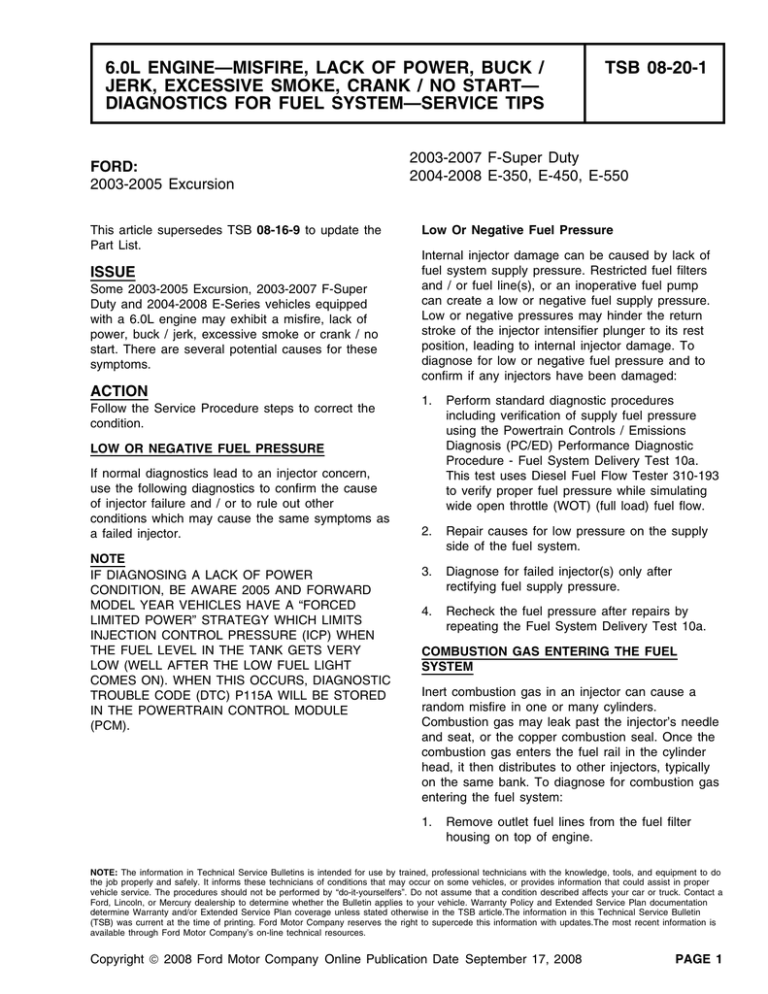
6.0L ENGINE—MISFIRE, LACK OF POWER, BUCK / JERK, EXCESSIVE SMOKE, CRANK / NO START— DIAGNOSTICS FOR FUEL SYSTEM—SERVICE TIPS FORD: 2003-2005 Excursion This article supersedes TSB 08-16-9 to update the Part List. ISSUE Some 2003-2005 Excursion, 2003-2007 F-Super Duty and 2004-2008 E-Series vehicles equipped with a 6.0L engine may exhibit a misfire, lack of power, buck / jerk, excessive smoke or crank / no start. There are several potential causes for these symptoms. ACTION Follow the Service Procedure steps to correct the condition. 2003-2007 F-Super Duty 2004-2008 E-350, E-450, E-550 Low Or Negative Fuel Pressure Internal injector damage can be caused by lack of fuel system supply pressure. Restricted fuel filters and / or fuel line(s), or an inoperative fuel pump can create a low or negative fuel supply pressure. Low or negative pressures may hinder the return stroke of the injector intensifier plunger to its rest position, leading to internal injector damage. To diagnose for low or negative fuel pressure and to confirm if any injectors have been damaged: 1. Perform standard diagnostic procedures including verification of supply fuel pressure using the Powertrain Controls / Emissions Diagnosis (PC/ED) Performance Diagnostic Procedure - Fuel System Delivery Test 10a. This test uses Diesel Fuel Flow Tester 310-193 to verify proper fuel pressure while simulating wide open throttle (WOT) (full load) fuel flow. 2. Repair causes for low pressure on the supply side of the fuel system. 3. Diagnose for failed injector(s) only after rectifying fuel supply pressure. 4. Recheck the fuel pressure after repairs by repeating the Fuel System Delivery Test 10a. LOW OR NEGATIVE FUEL PRESSURE If normal diagnostics lead to an injector concern, use the following diagnostics to confirm the cause of injector failure and / or to rule out other conditions which may cause the same symptoms as a failed injector. NOTE IF DIAGNOSING A LACK OF POWER CONDITION, BE AWARE 2005 AND FORWARD MODEL YEAR VEHICLES HAVE A “FORCED LIMITED POWER” STRATEGY WHICH LIMITS INJECTION CONTROL PRESSURE (ICP) WHEN THE FUEL LEVEL IN THE TANK GETS VERY LOW (WELL AFTER THE LOW FUEL LIGHT COMES ON). WHEN THIS OCCURS, DIAGNOSTIC TROUBLE CODE (DTC) P115A WILL BE STORED IN THE POWERTRAIN CONTROL MODULE (PCM). TSB 08-20-1 COMBUSTION GAS ENTERING THE FUEL SYSTEM Inert combustion gas in an injector can cause a random misfire in one or many cylinders. Combustion gas may leak past the injector’s needle and seat, or the copper combustion seal. Once the combustion gas enters the fuel rail in the cylinder head, it then distributes to other injectors, typically on the same bank. To diagnose for combustion gas entering the fuel system: 1. Remove outlet fuel lines from the fuel filter housing on top of engine. NOTE: The information in Technical Service Bulletins is intended for use by trained, professional technicians with the knowledge, tools, and equipment to do the job properly and safely. It informs these technicians of conditions that may occur on some vehicles, or provides information that could assist in proper vehicle service. The procedures should not be performed by “do-it-yourselfers”. Do not assume that a condition described affects your car or truck. Contact a Ford, Lincoln, or Mercury dealership to determine whether the Bulletin applies to your vehicle. Warranty Policy and Extended Service Plan documentation determine Warranty and/or Extended Service Plan coverage unless stated otherwise in the TSB article.The information in this Technical Service Bulletin (TSB) was current at the time of printing. Ford Motor Company reserves the right to supercede this information with updates.The most recent information is available through Ford Motor Company’s on-line technical resources. Copyright 2008 Ford Motor Company Online Publication Date September 17, 2008 PAGE 1 TSB 08-20-1 (Continued) 2. Install a balloon over each fuel line with a zip tie. 3. Disable the fuel pump and fuel injection control module (FICM) relays. 4. Crank engine and watch for compression pulses in the balloon. 5. For each line where compression pulses are evident, remove all but one (1) of the glow plugs from the affected cylinder head(s). 3. Remove injector and inspect copper washer crush pattern. An even circular crush pattern should be visible on sealing surface of copper washer. If the crush pattern is not visible or not a complete even circular pattern (c shape pattern), the copper injector washer can leak or fail prematurely. 4. Possible causes of damage to the copper washer could be: a. Damaged injector hold down. 6. Crank engine and watch again for compression pulses. b. Hold down bolt stretched from improper torque. 7. Remove the glow plug and transfer it to the next cylinder in the head and repeat Step 6. Repeat this step for all four (4) cylinders on the effected bank, do not stop repeating until all four (4) cylinders are checked. c. Damaged injector. 8. For each cylinder where compression pulses are evident remove injector(s) and inspect copper gasket and lower O-ring, replace if necessary. If gasket(s) and O-ring(s) are okay replace injector(s) to address leakage past the injector pintle (needle). Re-test to confirm repair. NOTE ANY TIME AN INJECTOR CLAMP IS LOOSENED AND / OR INJECTOR REMOVED, THE COPPER GASKET AND O-RINGS MUST BE REPLACED, THEY CAN NEVER BE REUSED. Copper Gasket Inspection 1. 2. Remove the suspect injector and inspect for a missing or damaged copper washer. Review repair history as a missing injector copper washer is most likely caused by improper injector torque at a prior repair for injector replacement. Using an injector, that is not damaged, install a new copper washer and install the injector per Workshop Manual Procedure 303-04C and tighten to 24 lb-ft (33 N•m). NOTE F-SUPER DUTY VEHICLES BUILT 1/16/2006 AND LATER AND E-SERIES VEHICLES BUILT 1/23/2006 AND LATER, INJECTOR TORQUE IS 26 LB-FT (35 N•m) AND UTILIZES A T-45 TORX BIT. PAGE 2 d. Damaged injector cup. NOTE AFTER REPLACEMENT OF ANY FAULTY COMPONENTS - WITH NEW COPPER WASHER REPEAT INJECTOR COPPER WASHER CRUSH TEST TO VERIFY CORRECT CRUSH PATTERN. NOTE ANY TIME AN INJECTOR CLAMP IS LOOSENED AND / OR INJECTOR REMOVED, THE COPPER GASKET AND O-RINGS MUST BE REPLACED, THEY CAN NEVER BE REUSED. THE INJECTOR CLAMP AND HOLD DOWN BOLT CAN BE REUSED IF THEY WERE PROPERLY TORQUED, BUT IF THERE IS INDICATION OF PREVIOUS IMPROPER TORQUING, THESE MUST BE REPLACED. ERRATIC HIGH PRESSURE OIL SUPPLY Erratic supply of high pressure oil to injectors may cause a rough running engine. High pressure oil flow can be disrupted by faulty check valve(s) or a faulty injection pressure regulator (IPR) valve. To diagnose, first perform a slow neutral run up in park / neutral. If the engine runs rough between 1200 and 2300 RPM proceed to Check Valve Diagnosis; if the engine runs rough between 3000 and 4000 RPM, perform PC/ED pinpoint test Q, if the engine continues to run rough between 3000 and 4000 RPM after having validated the ICP sensor and connector, then replace the IPR valve. Check Valve Diagnosis 1. To isolate the bank with the faulty check valve, disconnect all of the injector electrical connectors on one bank. TSB 08-20-1 (Continued) 2. Perform a Power Balance test. Engine misfires should be constant on the four disconnected cylinders and the operational cylinders should be contributing evenly. 3. Repeat Steps 1 and 2 on the opposite bank. 4. If the operating contribution is erratic on one bank, replace the check valve on that bank. PART NUMBER 3C3Z-9E527-ECRM 4C3Z-9E527-BRM 3C3Z-9229-AA 3C3Z-6N853-BA 5C3Z-9A332-A 3C3Z-9C968-AA OPERATION MT082001 DESCRIPTION TIME Use SLTS Operations If Actual Available; Claim Additional Time Diagnosis Or Labor Performed As Actual Time DEALER CODING CONDITION BASIC PART NO. CODE 9E527 42 PART NAME Injector 2003 - 2004 Injector 2004 - Current O-ring and Gasket Check Valve 2003 - 2004 Check Valve 2004 - Current IPR valve WARRANTY STATUS: Eligible Under Provisions Of New Vehicle Limited Warranty Coverage And Emissions Warranty Coverage IMPORTANT: Warranty coverage limits/policies are not altered by a TSB. Warranty coverage limits are determined by the identified causal part. PAGE 3
